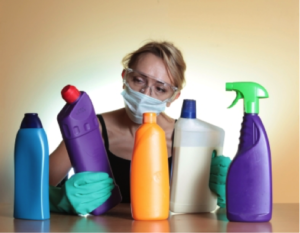 Most of us haven’t taken a close look at the chemical content of our common household cleaners, skin care products and makeup to find out that there are dangerous chemicals lurking in the ingredients list. The next time you are clearing out your cabinets by yourself or with one of us, Professional Organizers, don’t just look at the expiration dates, check the ingredients and keep the information below in mind.
Most of us haven’t taken a close look at the chemical content of our common household cleaners, skin care products and makeup to find out that there are dangerous chemicals lurking in the ingredients list. The next time you are clearing out your cabinets by yourself or with one of us, Professional Organizers, don’t just look at the expiration dates, check the ingredients and keep the information below in mind.
I went to a meeting hosted by Physicians for Social Responsibility, a group that looks at potential hazards facing our society. At the meeting, they showed a short video by Annie Leonard called the “Story of Cosmetics.” The video was followed by a discussion questioning the pervasive use of toxic chemicals in our beauty products, from lipstick to baby shampoo, chemicals that are known to contain carcinogens, neurotoxins, reproductive toxins and heavy metals, like lead and mercury. I was shocked to find out that lipsticks contain lead. Although I understand that it is hard to live in a lead free world, as Annie Leonard questions, “Do we have to put lead in our lipsticks?” I even found this to be the case when I went searching for new lipsticks in Whole Foods in the “organic” cosmetic department!
Harmful chemicals are not just in our cosmetic bags. Our homes are filled with fumes from harmful petrochemical solvents that are added to everyday house cleaners. “The average household contains anywhere from 3 to 25 gallons of toxic materials, most of which are in cleaners,” notes Ava Anderson, a young entrepreneur, who at age 14 went in search of personal care products that did not contain harmful chemicals and couldn’t find any. In response, Ava started her own company selling healthier choices for skin care and cleaning products. At the heart of her company is a commitment to educate the public about the chemical content in products we use without worry or concern for their potential cumulative and lasting effects to our health and wellbeing.
Like Annie Leonard, Ava’s research finds disturbing facts that most of us do not know, facts that might shape our buying habits moving forward. Below are highlights from Ava’s list:
Below are Gaiam Life’s “8 Household Cleaning Agents to Avoid” and why:
The “All You” website also has a list of 6 chemical hazards hiding in your home, for those of you who are interested in more information.
If like me, after confronting this information, you’re heading to your cupboards, toiletry bags and makeup kit to do some tossing, the next question would be, “then what can I use instead?” Below are suggestions to get you started using baking soda, white vinegar, fresh lemons and coconut oil.
Baking Soda
Here are suggested uses for baking soda from The Farmer’s Almanac and “All You” websites:
White Vinegar
White vinegar can replace many common cleaning products you now may want to avoid. Here are suggestions from the “All You” website:
Lemons
Lemons offer alternatives to both cleaning products and beauty care. Here are suggestions from the “All You” website:
Coconut Oil
Coconut is the newest addition to my healthier cabinets & toiletry bag. Here are some of my favorites uses from the “Derm Store.”
Well, I hope you found some good, enticing alternative product ideas for your mop closet and makeup bag. It has been fun trying out and discovering healthier products and now, sharing them with all of you. May you too enjoy your journey towards healthier products.
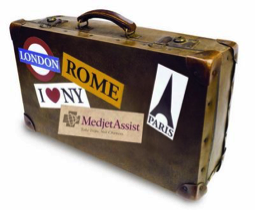 To roll or not to roll…that is the question. There’s a lot of debate about the best way to pack a bag for travel. We’ve used three different methods with our clients. The best method depends on the purpose of the trip, the kind of clothing you are taking, if you prefer hanging your clothes at your destination and wrinkle control.
To roll or not to roll…that is the question. There’s a lot of debate about the best way to pack a bag for travel. We’ve used three different methods with our clients. The best method depends on the purpose of the trip, the kind of clothing you are taking, if you prefer hanging your clothes at your destination and wrinkle control.
Layering
In the layering or bundling method, layer the clothes in a crisscross fashion in the suitcase and intertwine them into a bundle. This is a great method to reduce wrinkles and we were easily able to pack as many as 25 items of medium sized women’s clothing in one 22” carry-on. The downside is that the entire bundle has to be removed and unwrapped to retrieve your clothing.
Rolling
Rolling the clothing is another popular method. You can roll each item individually or group like items together and roll as a bundle. We found that grouping like items together does save some extra space and reduce some of the wrinkling that can occur with various fabrics when rolled.
Folding
And finally, the folding method. This method does take up more space than layering or rolling. However, for some fabrics, it’s a better way to reduce wrinkling. Folding the clothing with a piece of tissue paper or plastic in the middle will reduce friction and therefore the wrinkles.
In the end, we found that a combination of methods often works best. Rolling items that don’t wrinkle easily and folding others with plastic were the easiest techniques to combine. Once the larger, bulkier items were placed in the suitcase, we filled in all the gaps with smaller items like underwear, tank tops, bathing suits and belts, so that every nook and cranny was filled.
Do you dread entering your laundry area because it’s filled with piles of dirty clothes and who knows what else? Now is a good time to make a clean, fresh start!
1. Visualize your ideal space.
· Picture how you would like the room to look and consider how it should better function.
2. Reduce the excess.
· Remove items that don’t belong in the laundry room and put them where they really should live.
· Eliminate items you don’t want (use up, share with others, donate, or toss).
3. Maximize the space.
· Install shelves or cabinets above and/or next to washer and dryer.
· If space allows, place a narrow rolling cart between your washer and dryer to store small items.
· Install a wall-hanging ironing board, hanging rack and/or folding table to save space.
4. Organize what you keep.
· Assign a home for each item, keeping similar items together.
· Keep frequently-used items close at hand and less-frequently used items higher or lower.
· Dedicate space for sorting dirty clothes; use bins or rolling carts to separate and contain whites, colors, delicates, and heavily soiled items.
6. Decorate the room.
· Hang artwork, put down a throw rug, purchase attractive hampers, etc. so you feel happy and peaceful in the room.
7. Develop a laundry schedule.
· Make doing laundry a ROUTINE – daily, every other day, weekly, etc.
· Make it as enjoyable as possible – fold laundry while watching TV, talking on phone, etc.
8. Get help from family members.
· Have family members empty pockets, pre-spot and put their dirty clothes in the hamper.
· Delegate the folding of clean laundry and putting clothes away.
9. Follow through!
· Complete the laundry cycle and put clothes away and have family members do the same.
· Reward yourselves with a treat when you’ve completed the process.
BONUS TIP #1: To have a truly clean start, take your accumulated laundry to your local laundromat and have them do the wash for you. Approximate cost = $1.00/lb.
BONUS TIP #2: Use Color Catchers (by Shout) or Color Grabber (by Carbona) when washing lights and darks together. They really do catch the color!
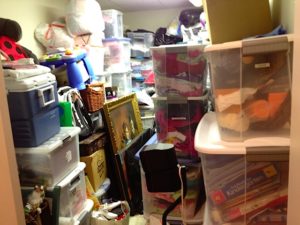 Have you heard the term situational disorganization? What is it and how does it happen?
Have you heard the term situational disorganization? What is it and how does it happen?
Situational disorganization is when an event occurs that we cannot control and we are not prepared for, causing our organizational systems to fall apart.
The cause can be as simple as returning from vacation to find that there is a flood in the basement. Everything needs to be moved or thrown out; the space needs to be repaired and workers are coming in and out. In the meantime, everything gets out of control. Sometimes a second crisis will come up, an illness, an elderly parent gets sick or needs to move…something that needs your immediate and ongoing attention. It becomes more than you can handle. Priorities need to be reassessed and action taken on the priorities. Sometimes your organization falls to the bottom of the priority list. Situational disorganization.
People will often blame themselves. They feel that they should be able to maintain their systems. Since it is situational, it is temporary. When the issue is resolved, it will be time gather your resources and get reorganized.
I have experienced this so many times, personally and with my clients. When my mother-in-law downsized at the same time I was moving, I ended up with a 20×17’ room full of furniture. I could have opened a store. It took a couple of months to sort through and decide what we were going to keep, sell and donate. Then we had to assign homes for what we were keeping. Situational disorganization.
When I broke my wrist earlier this year, I had limited use of my right hand and could not put things away. I would put items on a table, and as my mobility improved, I would put them away. This went on for about three weeks and there was a lot to put away. Situational disorganization.
Other causes of situational disorganization that I have seen are: a client being treated for cancer while undergoing a home renovation; people blending households; a business taking off before the owners were ready; a caretaker prioritizing a parent’s health, resulting in bags and bags of paper after five years of caregiving; a divorce resulting in depression and an inability to manage the home; and accidents leaving people physically unable to deal with day-to-day activities for a period of time.
This may be you. If it is…know and plan that when you get through the crises that led you here, you will get back to your familiar, organized world!
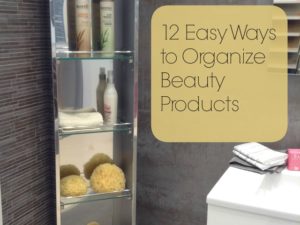 Organizing your beauty products will cut down on the time it takes to get ready in the morning and will start your day off on an organized, empowered note. Here are 12 easy ways to get started:
Organizing your beauty products will cut down on the time it takes to get ready in the morning and will start your day off on an organized, empowered note. Here are 12 easy ways to get started:
1. Keep only the items you use every single day in your medicine cabinet. Leave room for the basics like your toothbrush and skincare. At least that part of your routine can be simplified to just one product for each step, even if you have a million choices for color and finishing touches.
2. For beauty items that coordinate with your outfit or the season, like blushers, eye shadows, and lip color, group them together by category so you can see your choices at a glance.
3. Use clear acrylic drawer dividers or decorative boxes to hold groups of each makeup type in drawers or on shelves.
4. Use wall space by adding bins like those found in kitchens to hang utensils. Add magnetic or hook and loop (Velcro) fasteners to hang items in plain view on the back of the medicine cabinet door. The back of the bathroom door can offer even more storage space with the addition of a clear see-through shoe pocket organizer.
5. The under-sink space is super-high value real estate. Use a 2-tier sliding organizer to make use of all the room under your sink, and to reduce spills and messes.
6. Minimize the amount of beauty product in your tub area. Find a shampoo and body wash that the whole family enjoys using rather than tripping over multiples.
7. Most tubs don’t have much built in storage. Add racks that hang over the shower head and offer 2-4 shelves to hold beauty products and gear. Or suspend another shower rod on the inside back wall at eye level to hold baskets that can hold even more beauty items or bath toys.
8. The 80/20 rule applies to most beauty products. We usually use 20% of our products 80% of the time, and most products get used barely at all. Decide which items are your favorites, and pack the rest away for a month. If you don’t go back into the box to retrieve any of those items, you can probably do without them altogether.
9. Repurpose whenever possible. Use mason jars, wooden boxes that were original packaging for nicer beauty products, and small tin pails from the garden department to help you sort items together and make them look nice.
10. Even simple plastic bins from the dollar store can look great if they are in the same color scheme and labelled nicely.
11. Update your light bulbs. It’s hard to organize what you can’t see.
12. If you are updating your space, ensure there are plenty of drawers to store your beauty products in. Most basic vanities don’t come with drawers. With drawers, you can easily separate your beauty stash and keep your counters clear so you have room to prep each morning.
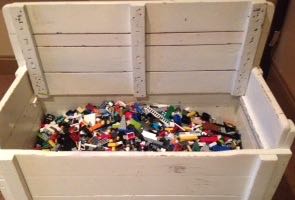 With being a mother of three boys, it comes as no surprise that we have a toy box ‘filled to the brim’ with LEGOs. That’s right, every color, shape, and size ever put on the market from 1998 until 2010. I have over 12 years of memories concealed in this toy box. So, when my boys suggested that we ‘get rid’ of the LEGOs, I admit that my heart sank a little bit. Immediately, I thought of the countless hours my boys spent imagining, creating, and building their creations and my constant amazement how these little blocks could hold one’s attention for so long. The actual toy box was my husband’s from his childhood. This in and of itself is a family ‘heirloom.’ So, does it make sense to discard this ‘treasure trove’ that I hold so dear? You would think that as a Professional Organizer it would be a ‘no brainer’…not so much.
With being a mother of three boys, it comes as no surprise that we have a toy box ‘filled to the brim’ with LEGOs. That’s right, every color, shape, and size ever put on the market from 1998 until 2010. I have over 12 years of memories concealed in this toy box. So, when my boys suggested that we ‘get rid’ of the LEGOs, I admit that my heart sank a little bit. Immediately, I thought of the countless hours my boys spent imagining, creating, and building their creations and my constant amazement how these little blocks could hold one’s attention for so long. The actual toy box was my husband’s from his childhood. This in and of itself is a family ‘heirloom.’ So, does it make sense to discard this ‘treasure trove’ that I hold so dear? You would think that as a Professional Organizer it would be a ‘no brainer’…not so much.
Do I purge on a regular basis? Yes. Although it comes naturally to me, I do try and live what I so often preach to my clients. “If it is no longer useful to you, why not bless someone with what you are no longer using?” Well, every now and then, sentimentality wins out. I am as sentimental as the next person and treasure certain items dearly. That being said, every item cannot and should not fall under this category. So, how does one choose?
First, you should ask yourself if the item holds good memories and brings you joy. If so, find a spot in your home to enjoy this treasure. Over the years, I have been gifted with many items from family, but have only kept what is useful to me. Take for instance your grandmother’s china. Maybe you have another set of fine china that appeals to you. If this is the case, donate or gift your grandmother’s set to someone else.
Second, take your storage space into consideration when deciding on what to keep. It does not take long for clutter to accumulate, and there is nothing worse than living in a cluttered environment. Also, if you can’t find the treasures when you want to use them, why hold onto them in the first place?
So, you’re probably wondering if I still have the white, wood toy box. The answer is yes! While my boys obviously don’t partake in building with LEGOs any longer, I have had on occasion, certain visitors who have enjoyed them. Also, it is located in our basement that was once our ‘toy room’ but has since been renamed the ‘workout’ room. Every now and then I get a glimpse of the toy box filled with LEGOs and my heart swells with wonderful memories of ‘years gone by.’